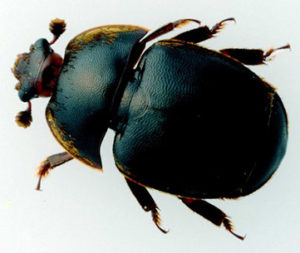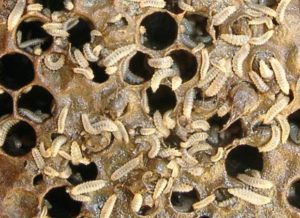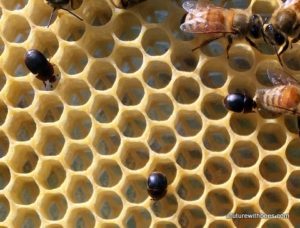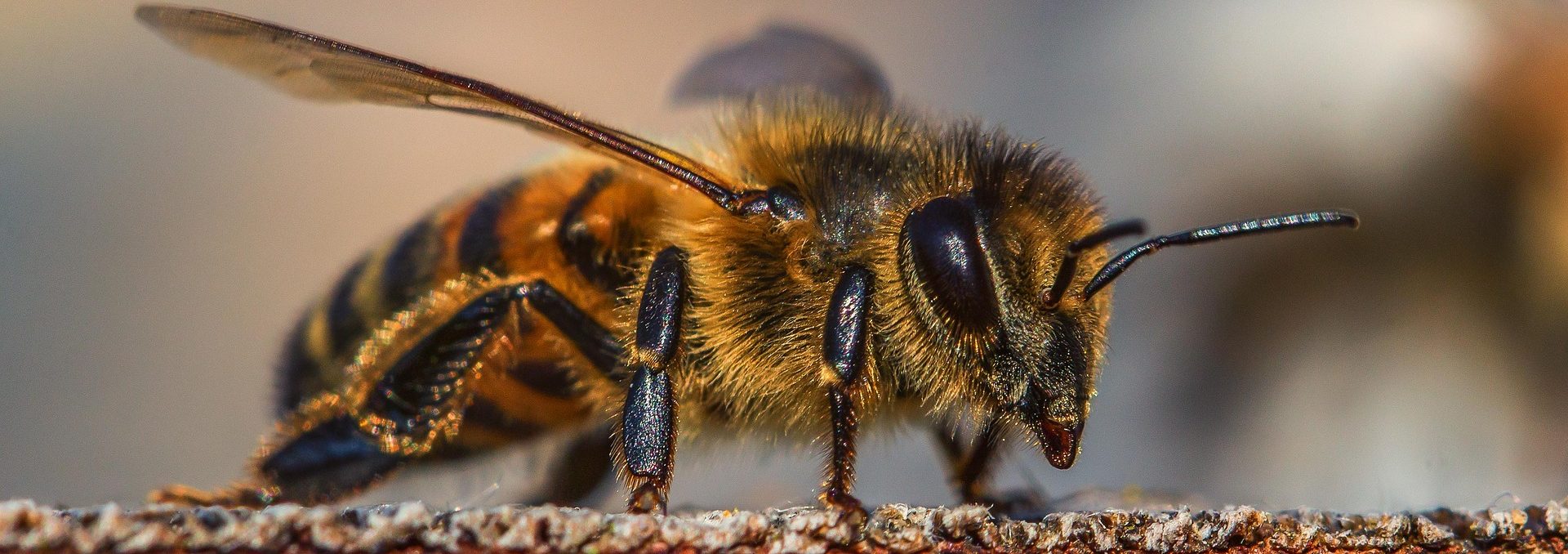Small hive b eetle (SHB), is a member of the Family Nitidulidae which contains a number of similar beetles native to Australia. This scavenger of honey bee colonies which originated from Sub-saharan Africa was first identified in Australia in October 2002. When identified, the SHB was well entrenched in feral and managed honey bee colonies, preventing any eradication attempt. The large number present and spread of the SHB indicated they had been in NSW for well over a year prior to identification. In their native homeland, SHB is considered a minor pest to the African species of honey bees. Where SHB incursions have occurred and European honey bees are managed in hot humid locations e.g. south-eastern USA 1998 and eastern Australia 2002, SHB has become a major pest of beekeeping industries.
eetle (SHB), is a member of the Family Nitidulidae which contains a number of similar beetles native to Australia. This scavenger of honey bee colonies which originated from Sub-saharan Africa was first identified in Australia in October 2002. When identified, the SHB was well entrenched in feral and managed honey bee colonies, preventing any eradication attempt. The large number present and spread of the SHB indicated they had been in NSW for well over a year prior to identification. In their native homeland, SHB is considered a minor pest to the African species of honey bees. Where SHB incursions have occurred and European honey bees are managed in hot humid locations e.g. south-eastern USA 1998 and eastern Australia 2002, SHB has become a major pest of beekeeping industries.
Identification
Eggs Pearly white colour, about 1.4 mm long and 0.26 mm wide, about two-thirds the size of a honey bee egg. Eggs are laid in irregular clusters usually in cracks and crevices in honey bee colonies, close to a food source.
Larvae Creamy white colour, growing to 10 mm long and 1.6 mm wide. They have six prolegs at the front of the body that provides good grip and two rows of small spines along their back. Unlike wax moth larvae which produce webbing (the damage left is dry), SHB larvae chew through combs, causing the honey to ferment, resulting in ‘sliming’ of the combs. It is this stage of the life cycle that causes the most damage to honey bee colonies.
rows of small spines along their back. Unlike wax moth larvae which produce webbing (the damage left is dry), SHB larvae chew through combs, causing the honey to ferment, resulting in ‘sliming’ of the combs. It is this stage of the life cycle that causes the most damage to honey bee colonies.
Pupae Mature larvae leave the hive to pupate within close proximity to the hive. They usually burrow into moist soil to a depth of 5–20 cm but can utilise a range of moist mediums. SHB can crawl large distances (>100 m) to find suitable conditions for pupation. Pupae start creamy white and change to a chestnut brown to black as they develop into an adult beetle form prior to emergence.
Adults Adult SHB are dark brown to black oval-shaped beetles, usually around 4–7 mm long and 2.5–3.5 mm wide. Size varies as a result of diet during  the larval stage. A partial covering of fine chestnut coloured hairs makes them difficult to pick up. The main recognisable features are rounded clubbed antennae, the abdomen protruding from the elytra (wing cases) and the shield shape of the pronotum (covering over the thorax). Finding SHB in a hive Locating SHB in a beehive can be difficult when SHB numbers are low. When there are large numbers present in the hive, SHB is readily seen scurrying to darker locations, avoiding the light. To locate SHB when in low numbers, there are two options.
the larval stage. A partial covering of fine chestnut coloured hairs makes them difficult to pick up. The main recognisable features are rounded clubbed antennae, the abdomen protruding from the elytra (wing cases) and the shield shape of the pronotum (covering over the thorax). Finding SHB in a hive Locating SHB in a beehive can be difficult when SHB numbers are low. When there are large numbers present in the hive, SHB is readily seen scurrying to darker locations, avoiding the light. To locate SHB when in low numbers, there are two options.
1. Open the hive. Place the lid on the ground and place the super squarely on it. Leave a few minutes and SHB will move down into the lid to avoid the light. Remove the super and inspect the lid for SHB. A similar approach can be used for the brood box using a loose bottom board.
2. Unobtrusive checking. In the hive, SHB seeks refuge from the harassment of bees. Placing a piece of core-flute or corrugated cardboard in the hive, sealed at one end, provides an ideal hiding location for the SHB (holes need to allow SHB entry but prevent bees). A wire can be attached to allow placement and removal via the hive entrance. Preferably position it at the rear of the bottom board. Leave for a few days and then remove and inspect for SHB
Potential damage
SHB are capable of prolific multiplication. Under laboratory conditions, 80 SHB can become more than 36,000 adult SHB by day 63. SHB can cause severe damage to honey bee colonies and stored equipment, resulting in the colony collapsing. Consuming bee eggs, bee brood, pollen and honey. Burrowing through combs and cappings, leaving them damaged. Thin-walled new combs are more susceptible than older combs. Defecating in and thereby contaminating honey with yeast that causes the honey to ferment, froth and weep out of the cells. Affected frames are said to be ‘slimed’. This honey is not usable for bee or human consumption.
Large numbers of SHB in a hive can result in the queen bee stopping laying and the colony absconding from the hive. Stored honey supers (full or extracted), stored hive equipment, broken frames, unclean extracting sheds etc. are all very susceptible to SHB larval damage because no bees are present to protect them from adult beetles laying eggs. Spoilage of honey damaged combs and increased SHB populations can result. It is estimated that 6000 SHB larvae can be reared from a single frame of brood. Weak or queenless hives are considered to be more susceptible to SHB damage than strong healthy colonies. However, all colonies are susceptible to damage when large numbers of SHB are present. Hive manipulation is also considered to increase the risk to colony breakdown, especially under conditions of high SHB numbers, temperature and humidity.
Management strategies
Many of the strategies to minimise SHB damage may only need to be utilised during the summer period when temperatures are reaching 30°C plus and humidity is 70% or higher. Under these conditions SHB activity increases and climatic conditions suit reproduction.
Maintain strong, healthy colonies with young productive queens.
Unite weak colonies together or combine them to strong colonies.
Boost weaker colonies with a frame of capped brood from strong colonies (make sure you are not transmitting AFB).
Avoid leaving clearer boards on hives beyond 2 days. As the bee to comb ratio declines so does the protection provided by the bees against the SHB. This can lead to a suitably warm location for rapid SHB development which can result in honey spoilage. Avoid areas of known high SHB populations during high-risk times. If SHB is a major problem where you have your bees, if possible move them to an area with less SHB or to an area less favourable for SHB reproduction (e.g. west of the Great Dividing Range).
Minimise cracks and crevices in the hive.
Take care when re-queening. The combination of hive stress, hive manipulation and an obstacle (queen cage) that prevents bee access to an area provides a set of circumstances suitable for SHB reproduction.
There are now a wide array of traps for SHB including commercially available bait traps such as Apithor.
Apithor Beetle Traps are available for purchase to members of our club via our club secretary Noela
